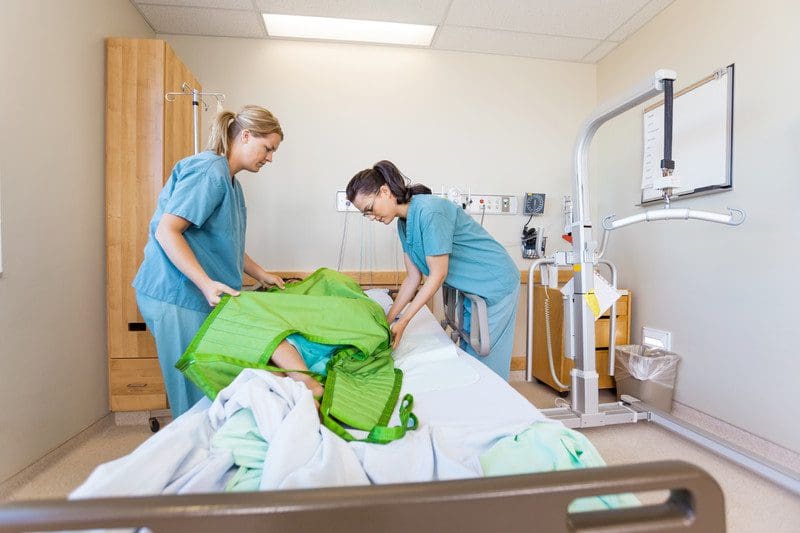Back Pain: Nowadays, nurses encounter the common question of how to prevent or even manage lower back pain. In fact, back complications are one of the most reported occupational health complications for nurses, especially through their retirement years. Many healthcare workers resort to self-medicating with over-the-counter pain relievers, but while these may offer relief from their symptoms, the effects are only temporary. Through several lifestyle changes, many nurses could achieve long-term relief from their lower back pain by managing their symptoms and preventing further low back complications.
First, stretching and exercising regularly should be fundamental for a nurse. Staying in a single position for long periods of time, as usual in the healthcare workplace, can place an unequal amount of pressure on the muscles, resulting in muscle weakness and uneven weight distribution. Stretching frequently on the job can help loosen up tight muscles and temporarily relieve back pain. Then following a series of stretches with exercise can help regulate and further reduce back pain because it strengthens the structures supporting the back muscles. Engaging in strength training exercises can help keep low back pain away longer. Additionally, stretching and exercising the body enough before back pain symptoms appear in the first place can also help prevent back complications.
Strength training exercises, such as body squats, can boost stability and strengthen the entire body. Pilates is also a beneficial exercise because it specifically focuses on increasing flexibility and strength.
Moreover, eating a healthy diet is crucial for nurses to prevent and manage low back pain. Due to the heavy demand of the job, it’s usually difficult for many nurses to follow a balanced, nutritional diet. Skipping meals, overloading with caffeine, or simply eating fast food meals when there’s little time between shifts these improper eating habits can contribute to weight gain. A lack of essential minerals in their diets, like calcium and potassium, can increase the risk of lower back complications without sufficiently meeting the body’s nutritional needs. The extra weight can add more pressure on the lower back area, leading to back strains and its well-known symptoms when the body carries a little more pounds than it should.
 Then, nurses should practice proper posture while in the workplace to avoid back complications. Lifting and transferring patients are the most common reasons nurses develop work-related musculoskeletal disorders. Although specific body mechanic techniques are practiced by many nurses, in the rush of a busy workday, the spine can be overexerted. It may eventually lead to damage or injury to the spine. Aside from this, sitting improperly for extended periods, reaching over in awkward positions, and standing for an even longer period of hours can place additional stress on the muscles and other tissues surrounding the spine.
Then, nurses should practice proper posture while in the workplace to avoid back complications. Lifting and transferring patients are the most common reasons nurses develop work-related musculoskeletal disorders. Although specific body mechanic techniques are practiced by many nurses, in the rush of a busy workday, the spine can be overexerted. It may eventually lead to damage or injury to the spine. Aside from this, sitting improperly for extended periods, reaching over in awkward positions, and standing for an even longer period of hours can place additional stress on the muscles and other tissues surrounding the spine.
While these types of tasks are almost inevitable in a nurse’s line of work, being mindful of your posture and correcting it from time to time can help greatly. Throughout your day, take note of your posture in the reflection of a mirror. When standing up, the spine should be aligned with the hips, and the stomach should be tucked in. When seated, try to keep your back straight and evenly distribute your weight on both hips. While working, also make sure to avoid abrupt changes in your position and remember to utilize proper body mechanics to prevent back strains.
And finally, because nurse occupations, and often other healthcare workplace occupations, require people to be constantly up on their feet, it’s essential to invest in proper footwear. Nurses’ shoes tend to be lighter than any other type of shoe. Most of them are made with specially designed materials to protect the individual’s feet, particularly from spills. There are even some types of nurses’ shoes that have a unique set of soles to help with balance in order to avoid slips and falls throughout a heavy work shift.
Many healthcare workers use other types of shoes at work. Still, the comfort and protection nurses’ shoes offer, including the proper arch support and quality of the materials used, can help increase an individual’s productivity at work by improving posture further and ultimately preventing and/or managing low back pain and other symptoms.
Sourced through Scoop.it from: www.elpasochiropractorblog.com
Nowadays, nurses encounter the common question of how to prevent or even manage lower back pain. In fact, back complications are one of the most reported occupational health complications for nurses, especially through their retirement years. Through several lifestyle changes, many nurses could achieve long-term relief from their lower back pain by managing their symptoms and preventing further low back complications.
Related Posts
By Dr. Alex Jimenez
Chiropractic Clinic Extra: Back Pain Treatment
Post Disclaimer
Professional Scope of Practice *
The information on this blog site is not intended to replace a one-on-one relationship with a qualified healthcare professional or licensed physician and is not medical advice. We encourage you to make healthcare decisions based on your research and partnership with a qualified healthcare professional.
Blog Information & Scope Discussions
Welcome to El Paso's Premier Wellness and Injury Care Clinic & Wellness Blog, where Dr. Alex Jimenez, DC, FNP-C, a board-certified Family Practice Nurse Practitioner (FNP-BC) and Chiropractor (DC), presents insights on how our team is dedicated to holistic healing and personalized care. Our practice aligns with evidence-based treatment protocols inspired by integrative medicine principles, similar to those found on this site and our family practice-based chiromed.com site, focusing on restoring health naturally for patients of all ages.
Our areas of chiropractic practice include Wellness & Nutrition, Chronic Pain, Personal Injury, Auto Accident Care, Work Injuries, Back Injury, Low Back Pain, Neck Pain, Migraine Headaches, Sports Injuries, Severe Sciatica, Scoliosis, Complex Herniated Discs, Fibromyalgia, Chronic Pain, Complex Injuries, Stress Management, Functional Medicine Treatments, and in-scope care protocols.
Our information scope is limited to chiropractic, musculoskeletal, physical medicine, wellness, contributing etiological viscerosomatic disturbances within clinical presentations, associated somato-visceral reflex clinical dynamics, subluxation complexes, sensitive health issues, and functional medicine articles, topics, and discussions.
We provide and present clinical collaboration with specialists from various disciplines. Each specialist is governed by their professional scope of practice and their jurisdiction of licensure. We use functional health & wellness protocols to treat and support care for the injuries or disorders of the musculoskeletal system.
Our videos, posts, topics, subjects, and insights cover clinical matters and issues that relate to and directly or indirectly support our clinical scope of practice.*
Our office has made a reasonable effort to provide supportive citations and has identified relevant research studies that support our posts. We provide copies of supporting research studies available to regulatory boards and the public upon request.
We understand that we cover matters that require an additional explanation of how they may assist in a particular care plan or treatment protocol; therefore, to discuss the subject matter above further, please feel free to ask Dr. Alex Jimenez, DC, APRN, FNP-BC, or contact us at 915-850-0900.
We are here to help you and your family.
Blessings
Dr. Alex Jimenez DC, MSACP, APRN, FNP-BC*, CCST, IFMCP, CFMP, ATN
email: coach@elpasofunctionalmedicine.com
Licensed as a Doctor of Chiropractic (DC) in Texas & New Mexico*
Texas DC License # TX5807
New Mexico DC License # NM-DC2182
Licensed as a Registered Nurse (RN*) in Texas & Multistate
Texas RN License # 1191402
ANCC FNP-BC: Board Certified Nurse Practitioner*
Compact Status: Multi-State License: Authorized to Practice in 40 States*
Graduate with Honors: ICHS: MSN-FNP (Family Nurse Practitioner Program)
Degree Granted. Master's in Family Practice MSN Diploma (Cum Laude)
Dr. Alex Jimenez, DC, APRN, FNP-BC*, CFMP, IFMCP, ATN, CCST
My Digital Business Card


